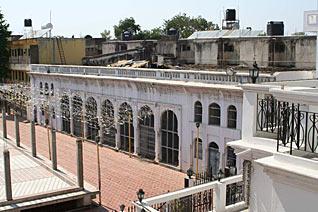Architecture
Architectural Heritage in Jeopardy
from notes by AMANDEEP SINGH MADRA and GURMEET KAUR RAI
The historic town of Nanded (Maharashtra, India) is an important place in Sikhdom because it is where Takht Sri Hazur Sahib, one of the five temporal thrones or seats of authority is located. It is where Guru Gobind Singh, the Tenth Teacher, is known to have meditated on the banks of river Godavari and where he spent his final days.
Just yards from these sacred spaces, plans are now in place to bulldoze a corridor that will destroy the last few historical reminders of the Guru's association with the region. Unique Sikh architecture that was built with devotion and served generations is slated for destruction rather than the sensitive conservation that they deserve.
Gurmeet Kaur Rai, the renowned architect/conservationist lead a team of experts to the area to petition the State and Gurdwara authorities to re-think their plans and conserve these buildings.
The year 2008 will mark 300 years of the Guruship of Guru Granth Sahib, the Sikh Scripture. Accordingly, a major event is planned by the Gurudwara board and the State Government in the town of Nanded when hundreds of thousands of pilgrims are expected to arrive at Hazur Sahib for the occasion.
In preparation for that event, numerous projects of infrastructure upgradation and environmental improvement are proposed and some are currently being undertaken so as to have befitting celebrations marking the event.
However, the threat to the historical built heritage has started as the Gurdwara and State authorities have started to bulldoze monuments in preparation for modern buildings to accommodate the pilgrims.
The site was visited by a team of conservation architects and urban designers on 21 December 2006 and this article briefly, brings forth some of the concerns related to the historic buildings in the town (within the precincts of Hazur Sahib) which are threatened to be demolished and some may just be lost due to sheer neglect.
The team was informed that much new construction by way of larger buildings and wider open spaces (referred to as a Galiyara) is proposed to be built around the inner shrine. Demolition activity is already in progress with much fervour around the inner shrine of Hazur Sahib.
The proposed plan lacks adequate sensitivity to the heritage buildings, some of them of sacred memory. These buildings include the Baradari (built in early 19th century by Maharaja Ranjit Singh to house the Guru Granth Sahib and the weapons of the Guru).
Also at great jeopardy is the Ramgarhia Bunga (also built by Maharaja Ranjit Singh to provide accommodation to the masons who arrived from Punjab to build the shrine of Hazur Sahib). The pavilion within the precinct of the bunga is in urgent need for conservation. But all out destruction can't be the answer.
The historic stepwell in the forecourt of the inner shrine, used by the pilgrims to wash their feet before entering the shrine, is in need of urgent restoration. The stepwell, incredibly well-built with fine stone masonry, fortunately still exists; sadly the Modikhana was demolished less than a month ago.
Another extremely important heritage site that needs urgent attention is the historic well in the court behind the inner shrine (associated with Guru Gobind Singh). Believed to have been blessed by Guru Gobind Singh, the water of the well is sweet and is still used in the langar for cooking. Numerous additions have been made to the structure which are insensitive to architectural standards and need to be removed and the well conserved.
The team met with numerous important people who are residents of Nanded and are closely linked with Hazur Sahib, including the head granthi, Giani Pratap Singh and the descendants of the Ramgarhia clan who are the current caretakers of the Ramgarhia bunga. Many local residents as well as pilgrims (both national and international) are seriously concerned about the loss and threat to heritage on account of this mindless demolition activity.
Many trees within the complex too are threatened to be removed as part of the Galiyara development program. For example - a small garden within the complex, trees of which need to be retained as a respite for the pilgrims from extreme weather conditions and for visual relief.
The team urgently recommends that while it is appreciated that the infrastructure needs to be upgraded, the proposed plan must be reviewed by a team of conservationists (cultural and natural) so as to ensure that the important aspects of the cultural landscape are preserved.
TO BE CONTINUED ..."History of Hazur Sahib Heritage Buildings"; and "What You Can Do to Stop the Destruction".
For further info: www.punjabheritage.org
Conversation about this article
1: Dr. Charanjit Singh [Punjab Pollution Control Board] (Patiala, Punjab), July 22, 2009, 3:14 AM.
Very informative article.



